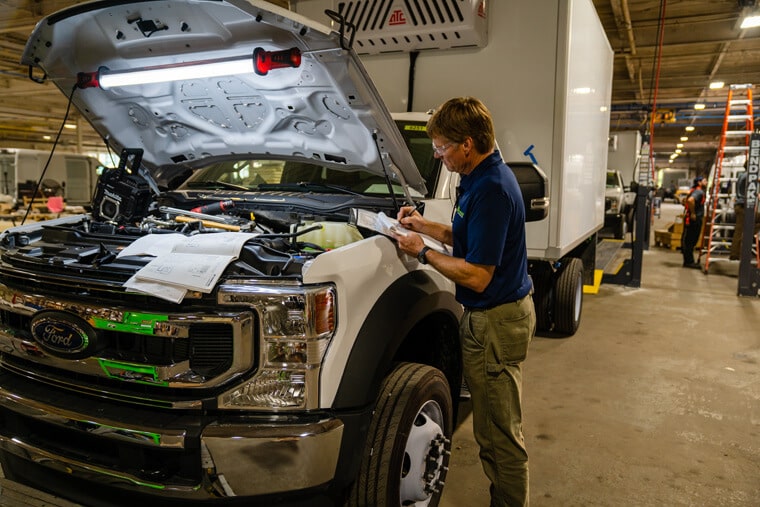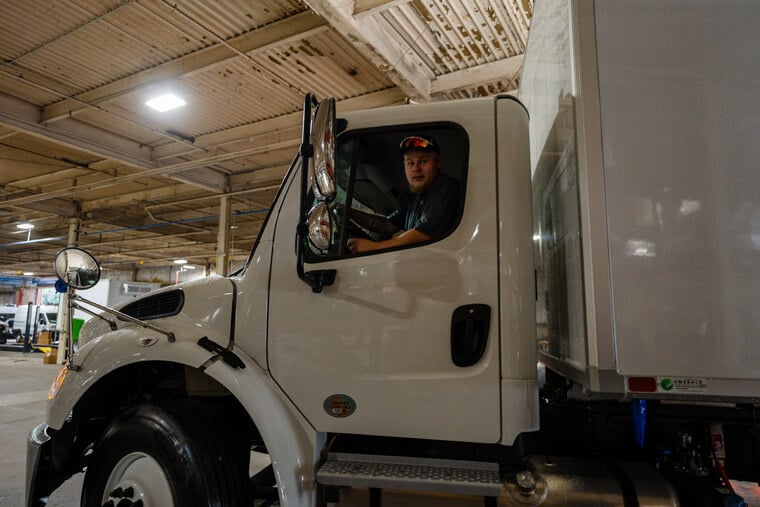
Why a Small Delivery Van Is Better for Urban Areas
Todd Cawley | October 28th, 2025
More isn’t always better, especially when it comes to last-mile deliveries. While the boom in e-commerce has brought with it several economic opportunities for fleets, it has also resulted in unprecedented challenges in the form of increased congestion, emissions, and safety concerns.
In this new delivery landscape, the use of traditional delivery trucks to get from point A to point B will no longer cut it — even more so as last-mile delivery is expected to grow by 12.8% in the next decade. If your fleet operations are expected to align with the current market outlook, then investing in smaller delivery vans will be vital. But in case you need some convincing, consider these five reasons why.
5 Reasons a Small Delivery Van Is Vital to Reach the Last Mile
Easier to Navigate in Urban Environments
The requirements for operating a delivery service in an urban area vary from those in the suburbs or rural locations. Typically, this delivery service type involves shorter distances, heavier traffic, and varying time spent on the road. This is because urban areas feature narrow streets with crossing pedestrians, other forms of traffic, and more obstacles.
A small delivery van is better suited for navigating these environments. It’s important for a delivery vehicle to be maneuverable to avoid collisions and protect cargo. Driving a small delivery van is easier when considering these variables because it has a tighter turning radius and shorter exterior dimensions. It’s also much easier to execute driving maneuvers like a U-turn or navigating tight alleyways and loading zones compared to larger trucks.
The added agility of a smaller delivery vehicle translates into increased efficiency, fewer detours, and shorter delivery times.
Simpler Parking and Urban Access
Various delivery services require specific types of vehicles, such as semi-trucks or insulated vans from refrigerated truck manufacturers. The size of your delivery vehicle determines how much cargo you can load, how efficiently you can drive on the road, and how quickly you can unload the product at a customer’s location.
In urban areas, vehicle size matters. Box trucks with low ceiling clearance can make unloading products difficult, impacting delivery time and putting perishable items at risk. There’s also the issue of finding parking, with trucks contributing to traffic congestion when a dedicated unloading zone is not present.
Smaller delivery vans excel in urban environments because they eliminate the issue of parallel parking or a high roof that prevents drivers from entering a parking deck. They also permit drivers to park in narrower spaces within urban areas to make deliveries. Since they’re more compact, drivers can avoid any unnecessary fines or time circling back to find a place to park and unload.
Likewise, smaller delivery vans typically have lower height and weight profiles, which enable them to enter residential streets that may have strict truck restrictions. Due to the size and height profile, drivers can get closer to the delivery location than with a larger vehicle.
Improved Fuel Efficiency and Lower Costs
Fuel is the largest variable expense on a fleet’s operating budget. While a delivery service can spend just as much time on the road in an urban area as in a rural location, larger vans or trucks have higher fuel consumption rates than smaller delivery vans, making them more expensive to operate.
Using a small delivery van improves your fleet’s fuel economy by requiring less gas to cover necessary routes. This is a significant advantage when delivering goods to metropolitan cities, which tend to have shorter routes but more pedestrians and vehicles, which eat up time spent on the road.
Another benefit of operating small delivery vans in urban environments is the lower cost of ongoing maintenance and insurance. Compared to their smaller counterparts, larger trucks are not built to withstand the wear and tear of frequent stops and idling, requiring frequent brake and tire replacements as miles rack up.
Likewise, insurance costs for smaller vehicles are lower. The bottom line? Leveraging smaller vehicles for urban deliveries will yield greater cost savings per mile than running a semi or box truck.
Safer and More Comfortable for Drivers
Safety is a key component to retaining drivers. While larger vehicles like semi-trucks have their place and role in fleet operations, they are often less safe to operate than smaller trucks or vans, particularly in urban environments.
Larger trucks have a larger turning radius, which can result in vehicle accidents. Likewise, they tend to have more blind spots and longer stopping distances, which increase the risk of workplace injury and vehicle collision. The compact design of small delivery vans makes them more ideal in these scenarios.
Small delivery vans also provide drivers with greater visibility and increased maneuverability, helping them sidestep potentially dangerous situations while out on the road. Newer models tend to have added safety features, such as cameras, sensors, and side doors. They can also be retrofitted with ergonomic features that make driving for extended periods more comfortable.
When a driver is more comfortable and feels safe, they’re less stressed and more alert, which reduces the risk of driver fatigue and mistakes on the road.
Support Sustainability and Compliance
The growth of e-commerce has resulted in more vehicles on the road, increasing carbon emissions, traffic congestion, and safety concerns. As a result, national, state, and local government agencies have passed several laws and regulations to curtail the impact.
While innovations in engine types are making both small and large vehicles more sustainable through electric and hybrid vehicles, in last-mile logistics, smaller delivery vans reign supreme. Small delivery vans consume less fuel, have a lower road carbon footprint, and emit less pollution and greenhouse gases.
As several cities adopt policies restricting high-polluting vehicles, diversifying your fleet with small delivery vans is both economical and more compliant. Additionally, small delivery vans tend to idle and brake less, which eases their impact on congestion and emissions.
Optimize Your Fleet for Urban Performance
While a small delivery van is essential for today’s operations, the key to successful fleet management is vehicle diversification. Use larger delivery trucks or vans for long-haul travel and smaller ones for local, urban deliveries. If payload capacity is a concern, consider optimizing the performance of small delivery vans by uplifting them with shelving, refrigeration units, and technology to achieve the right size vehicle for your operations. We cover options for customizing your truck or van here.
Interested in exploring the different types of vans you can leverage for your operations? We cover the most common ones in our latest guide. But if you’re looking to invest in a delivery van today, let Emerald Transportation Solutions be your one-stop shop for all your delivery vehicle needs. Explore our broad selection of insulated trucks, vans, and reefers to optimize your transportation process. Contact us today to address any questions about our products.
Editor’s Note: This blog was originally published in May 2022 and has been updated for comprehensiveness in October 2025.
Related Articles
Contact Us
Feel Free To Contact Us If You Have Any Questions
What does under DOT mean?
Questions regarding DOT requirements come up often. 10,000 lbs GVW (gross vehicle weight) and over are commercial vehicles that fall under the Department of Transportation regulatory requirements.
What is the difference between GVW and payload?
GVW or Gross Vehicle Weight is the entire weight of the vehicle including the payload. The payload weight represents the amount of cargo you are hauling.
What is a self-powered unit and a vehicle-powered unit?
A self-powered unit has its own fuel source and will run independent of the truck. This is the heaviest and most expensive option. While vehicle-powered units run off the engine via a compressor mounted on the engine. These are less expensive and lighter in weight but you must run the truck or plug the electric standby into shore power.
What does K-factor mean and why is that important?
K-factor is a term that stands for the overall insulating value of the container (truck body). Quite simply the lower the K-factor the better the truck body will be able to maintain a given temperature and require less energy to do so.
How much lighter is a Poly Van vs a US spec body?
Poly Van bodies are very light. On average we estimate we are 75-150 lbs per foot lighter than a traditional sheet and post foamed in place body. These weight savings translates to less fuel burn and less CO2 emissions, along with added payload, the most important benefit.






